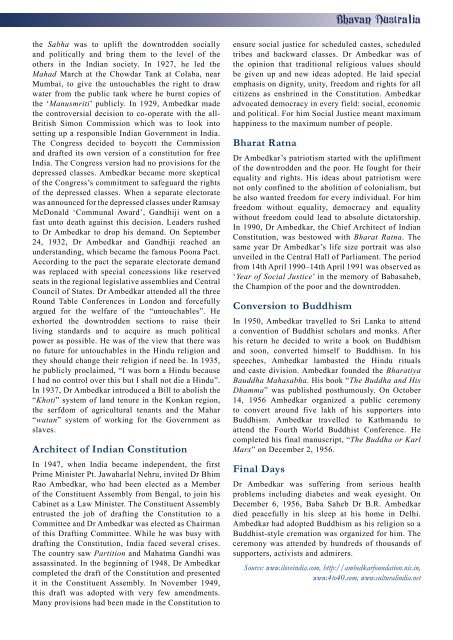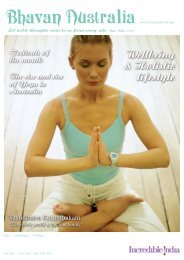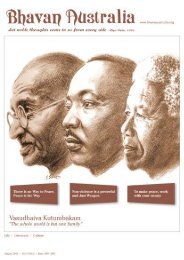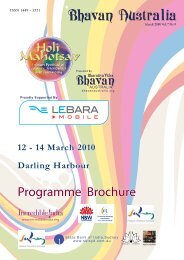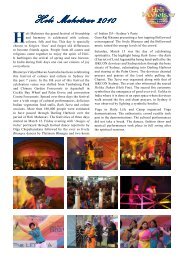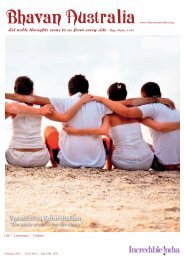'The whole world is but one family' - Bharatiya Vidya Bhavan Australia
'The whole world is but one family' - Bharatiya Vidya Bhavan Australia
'The whole world is but one family' - Bharatiya Vidya Bhavan Australia
Create successful ePaper yourself
Turn your PDF publications into a flip-book with our unique Google optimized e-Paper software.
the Sabha was to uplift the downtrodden socially<br />
and politically and bring them to the level of the<br />
others in the Indian society. In 1927, he led the<br />
Mahad March at the Chowdar Tank at Colaba, near<br />
Mumbai, to give the untouchables the right to draw<br />
water from the public tank where he burnt copies of<br />
the ‘Manusmriti’ publicly. In 1929, Ambedkar made<br />
the controversial dec<strong>is</strong>ion to co-operate with the all-<br />
Brit<strong>is</strong>h Simon Comm<strong>is</strong>sion which was to look into<br />
setting up a responsible Indian Government in India.<br />
The Congress decided to boycott the Comm<strong>is</strong>sion<br />
and drafted its own version of a constitution for free<br />
India. The Congress version had no prov<strong>is</strong>ions for the<br />
depressed classes. Ambedkar became more skeptical<br />
of the Congress’s commitment to safeguard the rights<br />
of the depressed classes. When a separate electorate<br />
was announced for the depressed classes under Ramsay<br />
McDonald ‘Communal Award’, Gandhiji went on a<br />
fast unto death against th<strong>is</strong> dec<strong>is</strong>ion. Leaders rushed<br />
to Dr Ambedkar to drop h<strong>is</strong> demand. On September<br />
24, 1932, Dr Ambedkar and Gandhiji reached an<br />
understanding, which became the famous Poona Pact.<br />
According to the pact the separate electorate demand<br />
was replaced with special concessions like reserved<br />
seats in the regional leg<strong>is</strong>lative assemblies and Central<br />
Council of States. Dr Ambedkar attended all the three<br />
Round Table Conferences in London and forcefully<br />
argued for the welfare of the “untouchables”. He<br />
exhorted the downtrodden sections to ra<strong>is</strong>e their<br />
living standards and to acquire as much political<br />
power as possible. He was of the view that there was<br />
no future for untouchables in the Hindu religion and<br />
they should change their religion if need be. In 1935,<br />
he publicly proclaimed, “I was born a Hindu because<br />
I had no control over th<strong>is</strong> <strong>but</strong> I shall not die a Hindu”.<br />
In 1937, Dr Ambedkar introduced a Bill to abol<strong>is</strong>h the<br />
“Khoti” system of land tenure in the Konkan region,<br />
the serfdom of agricultural tenants and the Mahar<br />
“watan” system of working for the Government as<br />
slaves.<br />
Architect of Indian Constitution<br />
In 1947, when India became independent, the first<br />
Prime Min<strong>is</strong>ter Pt. Jawaharlal Nehru, invited Dr Bhim<br />
Rao Ambedkar, who had been elected as a Member<br />
of the Constituent Assembly from Bengal, to join h<strong>is</strong><br />
Cabinet as a Law Min<strong>is</strong>ter. The Constituent Assembly<br />
entrusted the job of drafting the Constitution to a<br />
Committee and Dr Ambedkar was elected as Chairman<br />
of th<strong>is</strong> Drafting Committee. While he was busy with<br />
drafting the Constitution, India faced several cr<strong>is</strong>es.<br />
The country saw Partition and Mahatma Gandhi was<br />
assassinated. In the beginning of 1948, Dr Ambedkar<br />
completed the draft of the Constitution and presented<br />
it in the Constituent Assembly. In November 1949,<br />
th<strong>is</strong> draft was adopted with very few amendments.<br />
Many prov<strong>is</strong>ions had been made in the Constitution to<br />
ensure social justice for scheduled castes, scheduled<br />
tribes and backward classes. Dr Ambedkar was of<br />
the opinion that traditional religious values should<br />
be given up and new ideas adopted. He laid special<br />
emphas<strong>is</strong> on dignity, unity, freedom and rights for all<br />
citizens as enshrined in the Constitution. Ambedkar<br />
advocated democracy in every field: social, economic<br />
and political. For him Social Justice meant maximum<br />
happiness to the maximum number of people.<br />
Bharat Ratna<br />
Dr Ambedkar’s patriot<strong>is</strong>m started with the upliftment<br />
of the downtrodden and the poor. He fought for their<br />
equality and rights. H<strong>is</strong> ideas about patriot<strong>is</strong>m were<br />
not only confined to the abolition of colonial<strong>is</strong>m, <strong>but</strong><br />
he also wanted freedom for every individual. For him<br />
freedom without equality, democracy and equality<br />
without freedom could lead to absolute dictatorship.<br />
In 1990, Dr Ambedkar, the Chief Architect of Indian<br />
Constitution, was bestowed with Bharat Ratna. The<br />
same year Dr Ambedkar’s life size portrait was also<br />
unveiled in the Central Hall of Parliament. The period<br />
from 14th April 1990–14th April 1991 was observed as<br />
‘Year of Social Justice’ in the memory of Babasaheb,<br />
the Champion of the poor and the downtrodden.<br />
Conversion to Buddh<strong>is</strong>m<br />
In 1950, Ambedkar travelled to Sri Lanka to attend<br />
a convention of Buddh<strong>is</strong>t scholars and monks. After<br />
h<strong>is</strong> return he decided to write a book on Buddh<strong>is</strong>m<br />
and soon, converted himself to Buddh<strong>is</strong>m. In h<strong>is</strong><br />
speeches, Ambedkar lambasted the Hindu rituals<br />
and caste div<strong>is</strong>ion. Ambedkar founded the <strong>Bharatiya</strong><br />
Bauddha Mahasabha. H<strong>is</strong> book “The Buddha and H<strong>is</strong><br />
Dhamma” was publ<strong>is</strong>hed posthumously. On October<br />
14, 1956 Ambedkar organized a public ceremony<br />
to convert around five lakh of h<strong>is</strong> supporters into<br />
Buddh<strong>is</strong>m. Ambedkar travelled to Kathmandu to<br />
attend the Fourth World Buddh<strong>is</strong>t Conference. He<br />
completed h<strong>is</strong> final manuscript, “The Buddha or Karl<br />
Marx” on December 2, 1956.<br />
Final Days<br />
Dr Ambedkar was suffering from serious health<br />
problems including diabetes and weak eyesight. On<br />
December 6, 1956, Baba Saheb Dr B.R. Ambedkar<br />
died peacefully in h<strong>is</strong> sleep at h<strong>is</strong> home in Delhi.<br />
Ambedkar had adopted Buddh<strong>is</strong>m as h<strong>is</strong> religion so a<br />
Buddh<strong>is</strong>t-style cremation was organized for him. The<br />
ceremony was attended by hundreds of thousands of<br />
supporters, activ<strong>is</strong>ts and admirers.<br />
Source: www.iloveindia.com, http://ambedkarfoundation.nic.in,<br />
www.4to40.com, www.culturalindia.net


